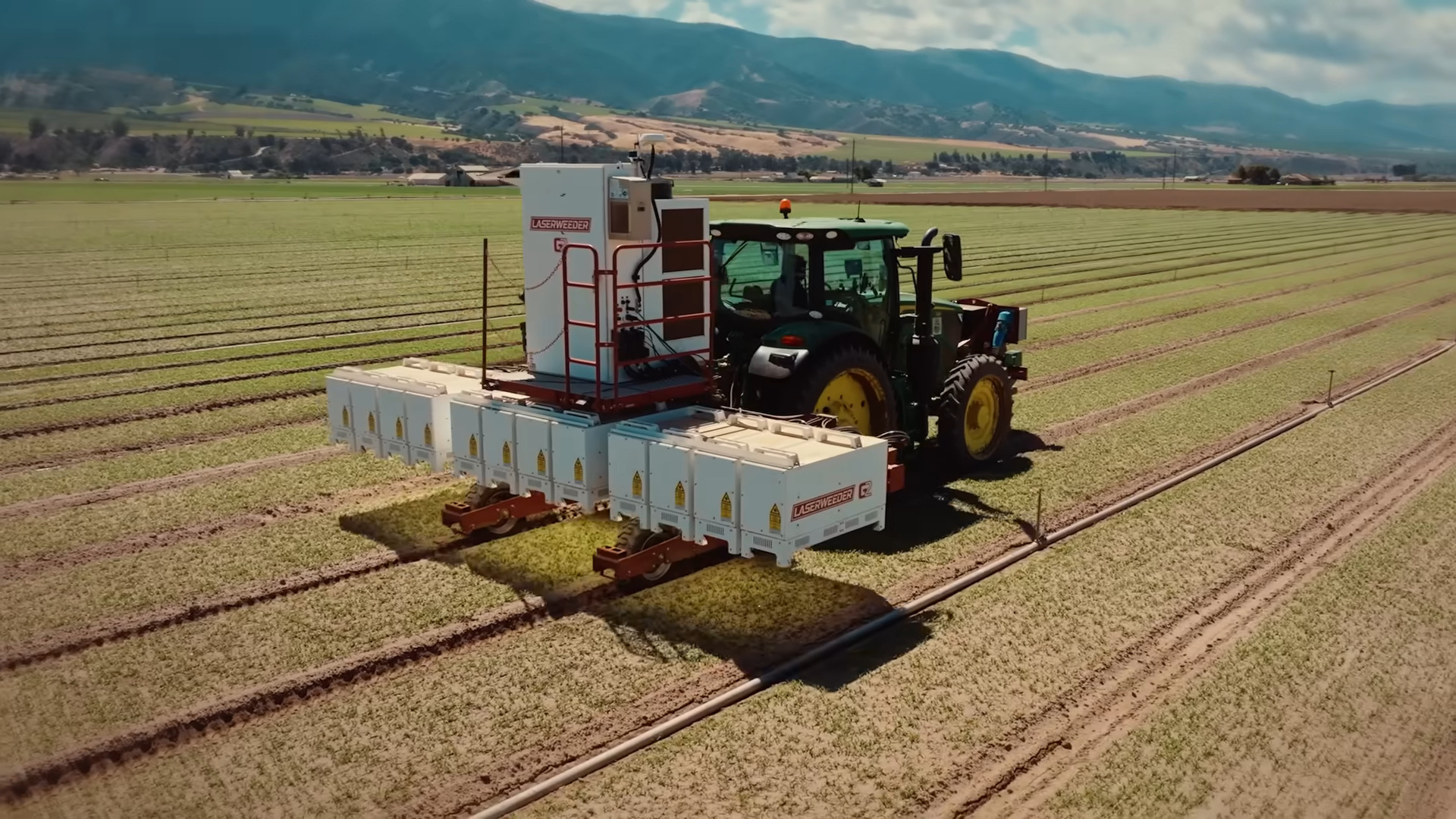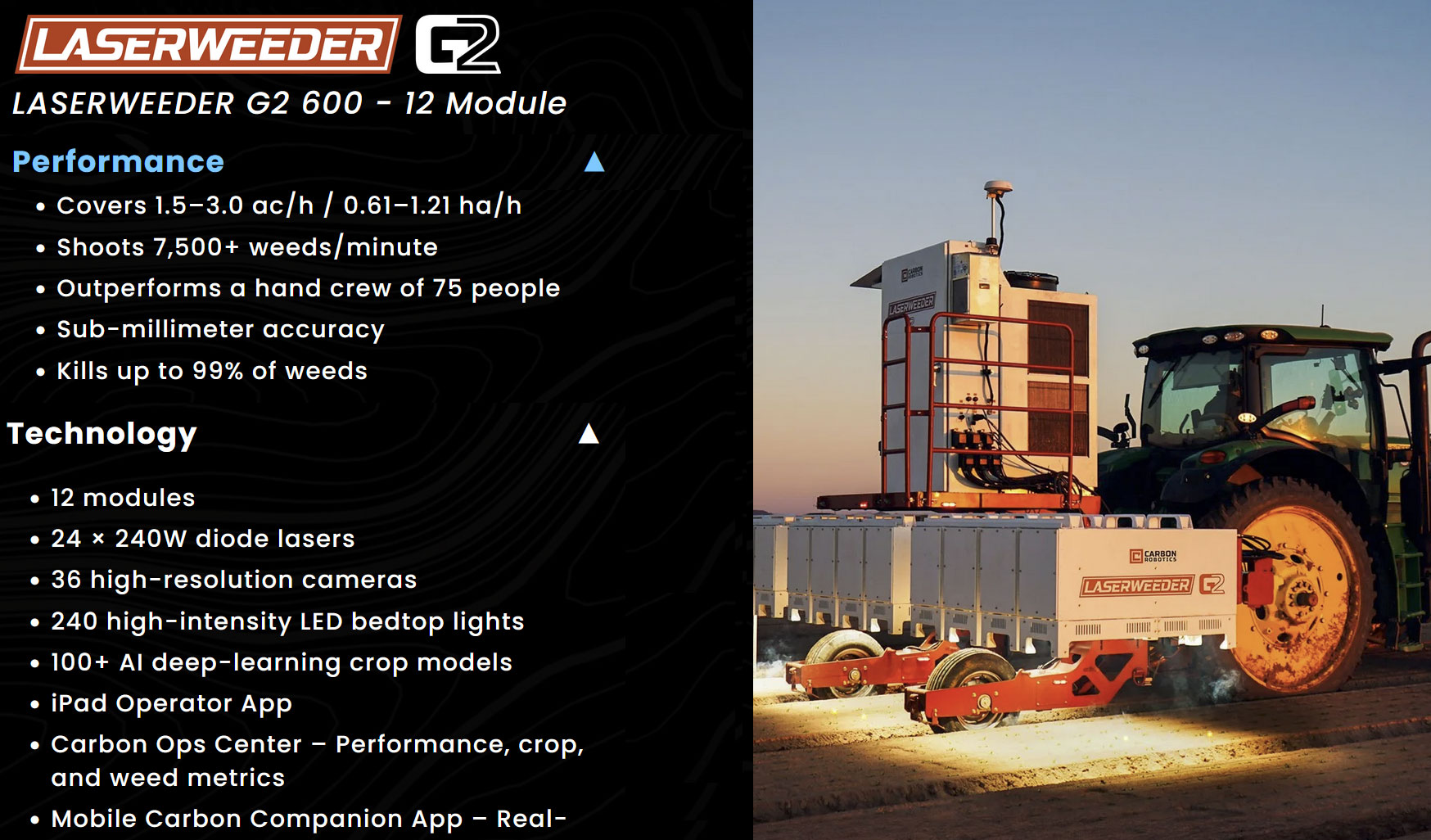LaserWeeder packs two dozen Nvidia GPUs and lasers to zap your weed problem, vaporizes ‘600,000 weeds per hour' with sub-millimeter precision — instant laser death for pesky weeds
Nvidia and Carbon Robotics’ tractor-pulled device is designed to kill large areas of weeds

Nvidia has revealed a surprising partnership with an agricultural robotics company whose flagship product deals out instant laser death to fields full of weeds. The awe-inspiring Carbon Robotics LaserWeeder G2 packs in 24 high power lasers and 24 Nvidia GPUs to facilitate its claimed “10,000 weeds per minute” zapping performance. That's equivalent to 600,000 weeds per hour, or 167 weeds per second.
Though the claimed performance is amazing, we aren’t talking about a compact, home garden-style device here. The flagship LaserWeeder G2 600 is a hulking tractor-pulled device spanning 20 feet. We note there are G2 models smaller than this flagship, but even the smallest G2 200 model is 110 x 85 x 127-inches and requires at least a 110hp tractor with 6,500 lbs lift capacity. The cut down size of the G2 200 reduces performance to 2,500 weeds per minute, which remains impressively rapid and equivalent to nearly 42 weeds per second.



Why laser your weeds?
Carbon Robotics is of course very positive about the qualities and performance of an AI and laser-powered weed control system. It highlights the trend of weeds becoming increasingly resistant to herbicides. It touts the sub-millimeter precision and identification accuracy of the Nvidia-accelerated ‘Large Plant Model’ weed identification system, which ensures your crops don’t fall to friendly fire. The robotics device is also a massive labor saver, outperforming “a hand crew of 75 people,” according to the product pages for the G2 600 model.
Interestingly, Carbon Robotics also aims to address the “global shortage of tractor drivers.” It is an autonomous retrofit for existing tractors, says the Nvidia blog. It can thus work long and ungodly hours. For extra safety, these autonomous tractors are said to be monitored via a remote operations center.
There are some downsides to devices like the G2, though. Such robotic machinery surely comes with a lofty price tag. Including the Nvidia GPUs and laser tech probably makes this tractor-pulled tech much more expensive than traditional farming machinery.
Also, those with experience of using devices which burn weeds will be aware that if a root survives, it sometimes doesn’t take very long for it to spring right back up. Lastly, there is some added hazard here, due to the laser technology inadvertently injuring someone’s eyes or skin. In arid areas, there may also be concerns about fires propagating from the fields to the surrounding countryside.
Follow Tom's Hardware on Google News to get our up-to-date news, analysis, and reviews in your feeds. Make sure to click the Follow button.
Get Tom's Hardware's best news and in-depth reviews, straight to your inbox.

Mark Tyson is a news editor at Tom's Hardware. He enjoys covering the full breadth of PC tech; from business and semiconductor design to products approaching the edge of reason.
-
SomeoneElse23 "Nividia and Carbon Robotics’ tractor-pulled device is designed to kill large areas of weeds"Reply
serious typo there. -
Sippincider Reply
Glyphosate resistant. Very cool if this gets wider use as weeds won’t be developing laser resistance.Konomi said:Weed problem? Depends on what kind we're talking here. -
Konomi Reply
Nah that's Nvidia & Nivea's collab brand. AI powered skincare products.SomeoneElse23 said:"Nividia and Carbon Robotics’ tractor-pulled device is designed to kill large areas of weeds"
serious typo there. -
yahrightthere Weeds have benefits to the microbiology of land (aka dirt).Reply
Plowing the weeds back under help stimulate a healthy soil system.
Cover crops are better, however weeds will do.
I am no expert, but lasering would not only remove the weeds but would sterilize the soil & mostly likely contribute to a dust bowl.
I recommend watching a series about the "BIGGEST LITTLE FARM" enlightening for sure. -
Notton I'm no expert either, but doesn't burning organic matter into ash and charcoal improve soil quality because microbes can feed off of that?Reply

